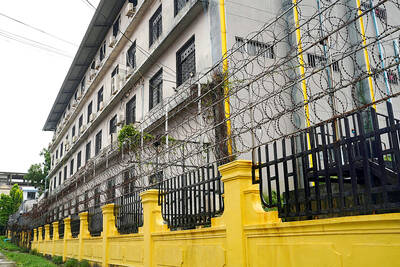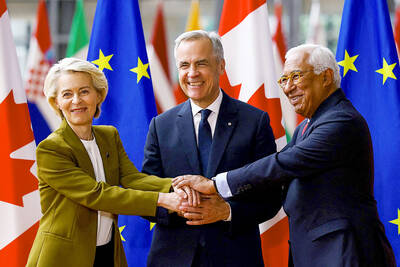As close encounters go, the claim by a woman that an alien attempted to seduce her on a country road sounds far-fetched, but files released yesterday reveal that it was considered serious enough for the British Ministry of Defence (MoD) to investigate.
The Norfolk woman who claimed she was approached by a man who said he came from another planet similar to Earth was questioned by the MoD intelligence branch DI55, whose brief was to investigate credible UFO reports.
She told them that, during their 10-minute chat, the man said his race was responsible for creating crop circles and explained the importance of contact between humans and his own people.
The woman, whose identity is not revealed in the government’s “X-Files,” was described by officials as “agitated” following the incident in which she “heard a loud buzzing noise behind her, then turned to witness a large, glowing spherical object rise steadily until it disappeared.”
The claims were examined by DI55 (whose very existence was denied by the government until recently) and described by an intelligence official as “one of our most unusual UFO reports.”
Other cases include the description of a black inverted boomerang-shaped UFO by two experienced air traffic controllers at Heathrow. The sighting, from the airport’s control tower on the morning of Dec. 17, 1992, came a week after numerous witnesses in Louth, Lincolnshire, reported seeing three lights attached to a large, triangular craft.
Yesterday’s release of the MoD documents also sheds light on one of Britain’s most infamous UFO episodes, namely the death of a US air force pilot, Captain William Schaffner, whom conspiracy theorists believe was killed during a duel with aliens above the North Sea.
On the evening of Sept. 8, 1970, Schaffner’s RAF Lightning crashed into the sea during a low-level exercise following take-off from RAF Binbrook, Lincolnshire. Schaffner’s body was never found, which became significant after claims emerged that Schaffner’s plane was scrambled to intercept UFOs.
Although the 28-year-old’s death continues to be attributed by some Internet sites to a secret war between aliens and earthlings, the MoD files contain a previously unreleased summary of the original RAF Board of Inquiry report into the crash, which makes no mention of UFOs. It concluded that the pilot’s death was a tragic accident.
One of the themes to emerge from these papers is the Aurora spy plane saga, with the files containing a little-known set of color photographs, apparently taken in the Scottish Highlands, which appear to show a large diamond-shaped UFO shadowed by military jets.
During the 1980s, rumors abounded about a spy plane codenamed Aurora, said to be capable of hypersonic speed. Although the US authorities denied its existence, alleged sightings frequently made headlines in UFO magazines. The DI55 papers confirm that officials also believed it was possible that someone was flying an advanced aircraft within UK air space.
The most intriguing incident involving such a craft occurred at 9pm on Aug. 4, 1990, at Calvine, a remote hamlet near Pitlochry in Scotland. According to the brief details released by the MoD, witnesses saw a diamond-shaped UFO hovering for about 10 minutes before it disappeared upwards at high speed. During the incident, Harrier jump jets were seen making a number of low-level passes. Color photographs reveal both the UFO and at least one of the jets.
Former MoD official Nick Pope described the photographs as “one of the most intriguing [UFO] cases in the MoD’s files.”
David Clarke, a lecturer in journalism at Sheffield Hallam University and author of Flying Saucerers: A Social History of UFOlogy said: “Many questions remain. Who was the photographer and how can we be sure his story was genuine? Why did the Daily Record decide not to publish the photographs in 1990? If they really were taken on the date stated, then why was the MoD unable to trace the origin of the Harriers clearly shown in the print?”

Drug lord Jose Adolfo Macias Villamar, alias “Fito,” was Ecuador’s most-wanted fugitive before his arrest on Wednesday, more than a year after he escaped prison from where he commanded the country’s leading criminal gang. The former taxi driver turned crime boss became the prime target of law enforcement early last year after escaping from a prison in the southwestern port of Guayaquil. Ecuadoran President Daniel Noboa’s government released “wanted” posters with images of his face and offered US$1 million for information leading to his capture. In a country plagued by crime, members of Fito’s gang, Los Choneros, have responded with violence, using car

CYBERCRIME, TRAFFICKING: A ‘pattern of state failures’ allowed the billion-dollar industry to flourish, including failures to investigate human rights abuses, it said Human rights group Amnesty International yesterday accused Cambodia’s government of “deliberately ignoring” abuses by cybercrime gangs that have trafficked people from across the world, including children, into slavery at brutal scam compounds. The London-based group said in a report that it had identified 53 scam centers and dozens more suspected sites across the country, including in the Southeast Asian nation’s capital, Phnom Penh. The prison-like compounds were ringed by high fences with razor wire, guarded by armed men and staffed by trafficking victims forced to defraud people across the globe, with those inside subjected to punishments including shocks from electric batons, confinement

The team behind the long-awaited Vera Rubin Observatory in Chile yesterday published their first images, revealing breathtaking views of star-forming regions as well as distant galaxies. More than two decades in the making, the giant US-funded telescope sits perched at the summit of Cerro Pachon in central Chile, where dark skies and dry air provide ideal conditions for observing the cosmos. One of the debut images is a composite of 678 exposures taken over just seven hours, capturing the Trifid Nebula and the Lagoon Nebula — both several thousand light-years from Earth — glowing in vivid pinks against orange-red backdrops. The new image

Canada and the EU on Monday signed a defense and security pact as the transatlantic partners seek to better confront Russia, with worries over Washington’s reliability under US President Donald Trump. The deal was announced after a summit in Brussels between Canadian Prime Minister Mark Carney and European Commission President Ursula von der Leyen and European Council President Antonio Costa. “While NATO remains the cornerstone of our collective defense, this partnership will allow us to strengthen our preparedness ... to invest more and to invest smarter,” Costa told a news conference. “It opens new opportunities for companies on both sides of the